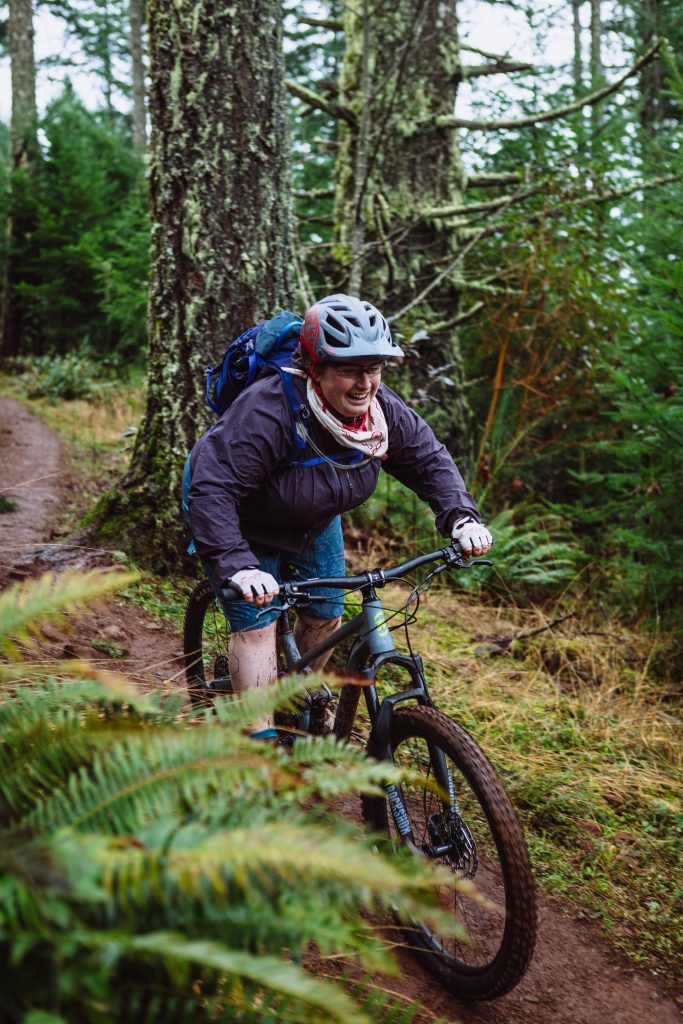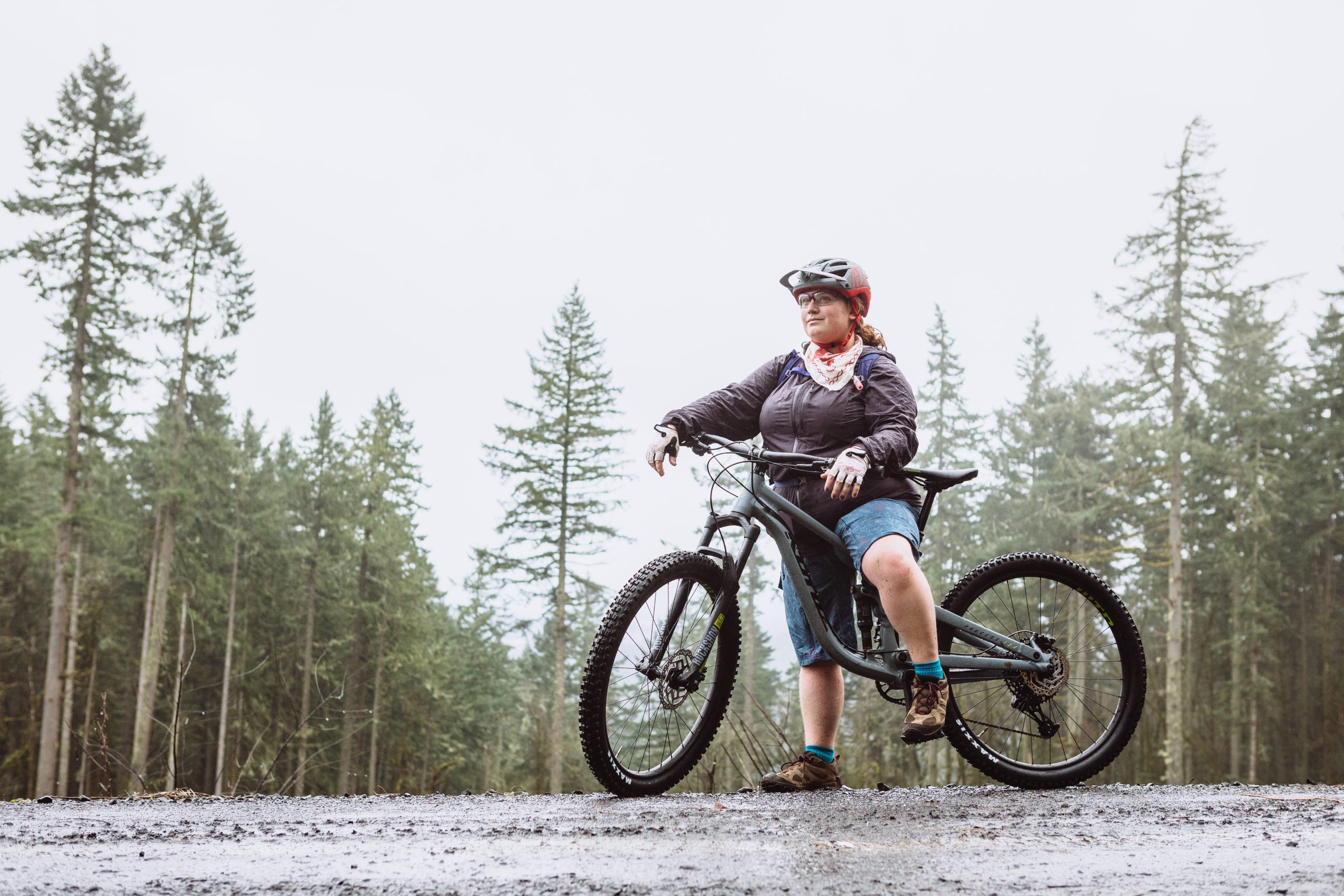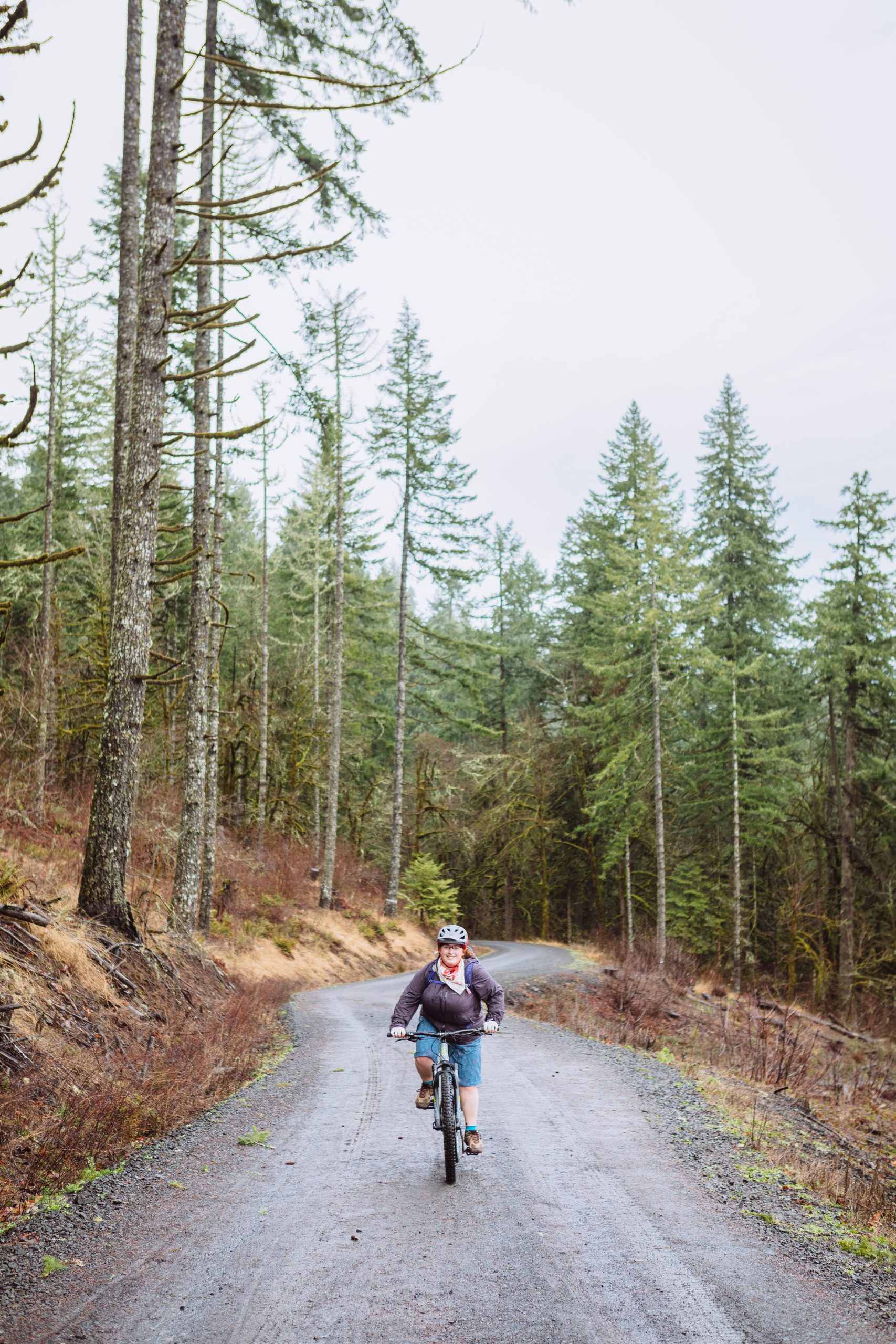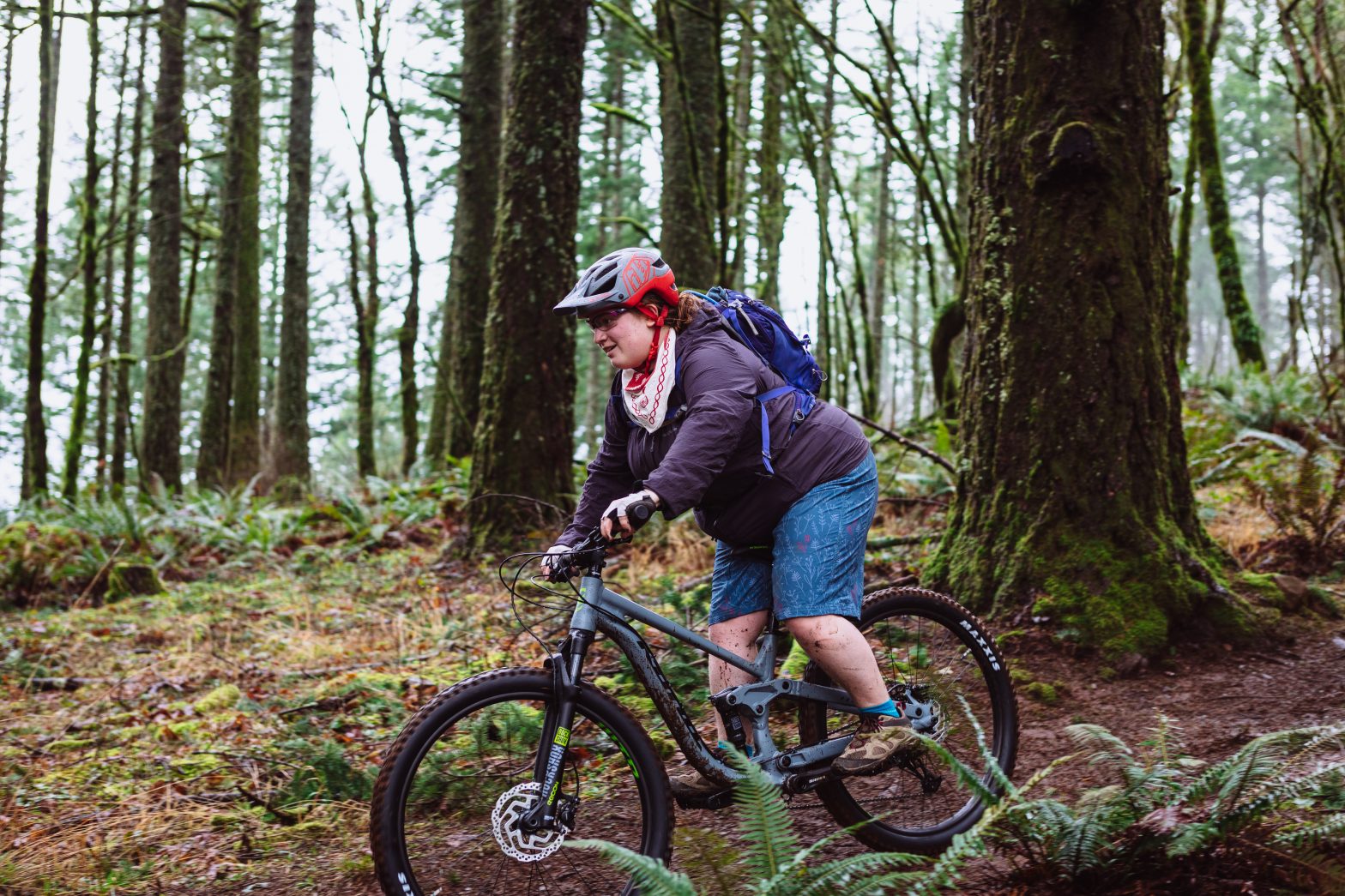At the WTF BX Summit in 2019, I co-facilitated a session called, “Fat Bikers: Creating Space for Body Size Inclusivity in Adventure Cycling.” Forty-five people from across the country participated in a dialogue about bodies and bikes and shared their experiences about bike culture, clothing, and equipment. As a result of everything I learned from the workshop, and my own experience as a fat cyclist – I summarized some ways we can work to create a more body-inclusive cycling community.
WRITTEN BY KAILEY KORNHAUSER
PHOTOS BY GRITCHELLE FALLESGON
FEATURED IN GET RAD BE RADICAL ISSUE 01


Fat is not a bad word
The first time I called myself fat, it was in writing. I felt butterflies as I typed the three letters into my essay, knowing that my peers would read the words the following week in class. I thought of a quote from Lindy West, “I always felt like if I didn’t mention it, then maybe people wouldn’t notice.” I imagined my friends reading my essay and quickly reacting to say, “You are NOT fat!” indicating to me, and everyone else that being fat is wrong, or lazy, or unattractive.
But I am fat, and fat is not a bad thing to be. There is power in reclaiming a descriptive word previously used as an insult. Often when fat people feel comfortable with their bodies, some label them as “confident” or “body positive.” Assigning these traits to people in larger bodies indicates that we are surprised by the way they act, that we would not feel confident or positive in a larger body. However, declaring my fatness is not an act of body positivity; it is a radical act meant to deconstruct the systematic ways in which society oppresses fat people. It is not enough for me to accept my body. Our culture must make space for me, as well.
And then there are the compliments. All too often, I find myself riding up a hill, only to be passed by a thinner faster rider who singles me out and says, “great work!” or “you’ve got this.” Statements like these remind me that other cyclists are surprised to see a fat body on a bike, or that they assume I’m on my bike to change my body size. But fat is what I am, not something I am trying not to be. I am not a before picture.
Fat people are not beginners just because they are fat.

Trust me; I’m a bicyclist
A week ago, I went to the grocery store to pick up a copy of Bicycling Magazine and some food for the week. I stood at the check-out counter, watching as the young cashier scanned each item. When he got to the magazine, he scanned it, then held it up and took a look at the cover. He considered it for a moment and then stated “I love mountain biking! Are you just getting into it?” For a moment, I was in disbelief. Then I quickly responded, “No. That is me. I’m on the cover of that magazine.”
Fat people are not beginners just because they are fat. Consider for a moment that a person’s body size or the speed that they are biking up a hill is in no way an indication of how much they bike. With that said, for many cultural and physical reasons, people in larger bodies may be reluctant to take up adventure cycling. It turns out fat people are a complex, nuanced, diverse range of people.

Acknowledge body privilege
Bodies come in a range of sizes and shapes. Body size privilege falls on a spectrum. Fatness is not one size fits all. Ash, the creator of the FatLips Podcast, created a helpful fatness spectrum that categorizes fat people from “small fat” to “infinifat” based on size and access to clothing. This spectrum provides terminology to express the differences and varying levels of oppression that people in larger bodies face across a range of sizes.
As a small fat person, my experiences with weight stigma are less severe than that of a person in a larger body.

Celebrate your body
Adventure cycling is a physical activity. Our bodies and our bikes transport us many miles, across vast landscapes. At times, we may feel like our bodies limit us. The body weight we carry, pain from previous injuries, forms of dysmorphia, and mental health may surface and create challenges as we ride a bike.
But in many ways, bike adventure celebrates what our bodies can do—a real-life demonstration of the true power of our bodies. We get in touch with the ways our bodies communicate with us, how they tell us when we are hungry, tired, or joyful. We connect with the way our body holds memories. Experiencing the physicality of our bodies can be a challenge, but celebrating ourselves is a path forward.


Fat people are not waterproof
I was wet. I’d been soaking for weeks actually, as I was in the middle of a 1,000-mile bikepacking trip across Alaska. Before leaving for the trip, I had spent weekends desperately looking for a raincoat. A company had generously offered to provide clothing for the journey, and I was embarrassed to admit that they didn’t offer jackets and pants in my size. I’d ended up with a stretchy windbreaker in a men’s size XXL that was “water-resistant,” which meant that it became soaked entirely in even a drizzle. With no other jacket and no rain pants, I had a freezing and very soggy five-week bike trip.
People in larger bodies are not waterproof. Fat people, like all other people, need rain jackets. Fat bicyclists, like bicyclists in all body sizes, wear bike shorts or jeans, or dresses when they ride. People in larger bodies have different tastes in fashion, different clothing budgets, and preferences for online or in-store shopping. According to the International Journal of Fashion Design, Technology, and Education, “The average size of an American woman is now between 16 to 18.” If the average size American is wearing an XL or XXL, then companies providing a size range that stops at XXL are not “size-inclusive,” they are just average.
People in larger bodies are not waterproof. Fat people, like all other people, need rain jackets.
As a small fat bicyclist, I have privilege and access to many bike clothing brands such as De Marchi and Terry that provide sizing up to XXL. But bikers just one size larger than me are limited significantly by available clothing. Pearl iZumi, She Beest, Shredly, and RSport all provide at least one size above XXL.
During the summit workshop, folks in larger bodies shared stories of challenges finding bicycling clothing in their sizes, and uncertainty about the types of clothes that work best for fat cyclists. While more and more brands are beginning to carry some extended sizes of cycling clothes, these sizes are often only available online. The industry must address that fat people are limited to styles and prices offered by the few brands providing some extended sizes. People in larger bodies need clothes for their bike adventures, and companies must make those clothes available.

Let’s talk about fat bikes
My commute to work began with a six-block downhill cruise into the city. As I turned my bike onto the steep decline, I pumped my brakes on and off a few quick times, hoping to manage my speed. When the brakes didn’t catch, and the bike didn’t slow, I began to panic. By the time I reached the second block, it had hit me like a ton of bricks: my brakes weren’t working. I was fast approaching a busy intersection and made a quick decision. I steered close to the curb and looked ahead for the best patch of grass. When I stood up in my now grass-stained jeans, my bike on the ground a few feet away, I began to cry.
For years, other bikers (mostly white men) told me that I must be using my brakes “incorrectly.” There was simply no way I could burn through brake pads so quickly. Two things were going on here:
- White men with a lot of mechanical bike knowledge were unable to imagine a world where I biked more than them
- No one wanted to talk about my weight.
earing parts, including pedals and brakes, at a faster rate than a lighter rider. It’s not rocket science, but it seemed revolutionary when I first learned this. Bikes themselves have what is called a structural weight limit, which refers to the maximum amount of weight a bike can physically support. Most bike manufacturers publish these weight limits in the bike manual for a specific model. While restrictions vary by type of bike and frame material (steel, carbon, aluminum), many bikes have a limit lower than 300 lbs. Wheels tend to have an even lower weight limit, and bikers in larger bodies are encouraged to consider wheelsets made with more durable materials such as steel and a higher number of spokes.

During the workshop at the WTF Summit, participants offered thoughts on how to approach the subject of weight limits and component wear in bike shops and casual settings. First, we must simply begin talking about it. When it comes to the function of a component as important as brakes, avoiding conversations about weight becomes a safety issue. While talking about bodyweight with a customer or friend may seem challenging, consider providing examples of what you would offer another biker in a similar situation. For instance, you can mention that a person weighing about 190 lbs. might load their shock to a certain pressure for a specific ride. Create space for the bicyclist to consider what this information means for them, or to speak openly about their own body.

Make space, make community
Groups like Unlikely Hikers, Fat Girls Hiking, and Climb Big are creating a community for experienced and beginner outdoor adventurers in larger bodies. These groups can serve as an example of how we can create space for body size inclusivity in adventure cycling. By hosting size-inclusive or explicitly fat spaces to participate in hiking and climbing, organizers have been creating a community of people in larger bodies already participating in these activities, while inviting beginners to join. Hiking and climbing events are led by people in larger bodies and media related to the events centers fat people in images. The organizers of these groups have been active in working with clothing and gear brands related to their activities to push for more size-inclusive equipment.
During the workshop, we had an uplifting discussion about how we can create cultural change in our bike community. Some ride organizers do this by being transparent about route length and elevation ahead of time and holding short social gatherings before rides begin so new or slower riders feel comfortable attending. Others suggested selecting fat bicyclists to lead group rides, signaling to other people in large bodies that these rides are a space for them.
Many of us shared experiences with “no-drop rides” that did not allow everyone the chance to rest at check-in points, with riders getting back onto their bikes as soon as the slowest person caught up.
Many of us shared experiences with “no-drop rides” that did not allow everyone the chance to rest at check-in points, with riders getting back onto their bikes as soon as the slowest person caught up. Others shared that setting check-in spots ahead of the ride made them feel less alone.
Bikers in smaller bodies provided some of the ways they work to be an ally to friends in larger bodies. By asking friends what they need on a ride, rather than assuming they want us to hang back with them or leave them be, we allow the rider to set expectations. And if there is uncertainty about a bike route or weight limits for equipment, bikers in smaller bodies can call ahead or speak up to a group of bikers, voicing concern for people of all sizes.
As the Summit session came to a close, I felt energized. WTF individuals of all sizes had taken time to learn and share about the ways we can create an adventure cycling community that is genuinely body
size-inclusive.
We had spent time exploring the experience of our bodies on bikes, and we had allowed ourselves to be vulnerable in sharing those experiences with others. There is so much more to learn, and we have a lot of work to do. But for now, I am proud to be surrounded by a community of adventure cyclists that live the way the world should be.
WRITTEN BY KAILEY KORNHAUSER
PHOTOS BY GRITCHELLE FALLESGON
FEATURED IN GET RAD BE RADICAL ISSUE 01



As a portly, 64 year old white male with 50 plus years riding experience on all types of mid to high end bikes, i applaud your efforts to generate awareness so that more larger body people will realize that they too can be riding. There have always been solutions for heavier riders, whom i have ridden with but manufacturers of bike frames and wheel sets and CLOTHING, can definitely wake up and offer more options. What do large people do for riding shorts that fit. And ive NEVER owned a cycling jersey. Cuz they’re cut to fit a skinny person. Corporate America have always discriminated against anyone who dont fit their ideals…whether its for a job or making a product. I cant find a job.HR wont ever admit to age and size disrimination. I know that companies dont want to hire 60 + year old, white, heavy set males either.